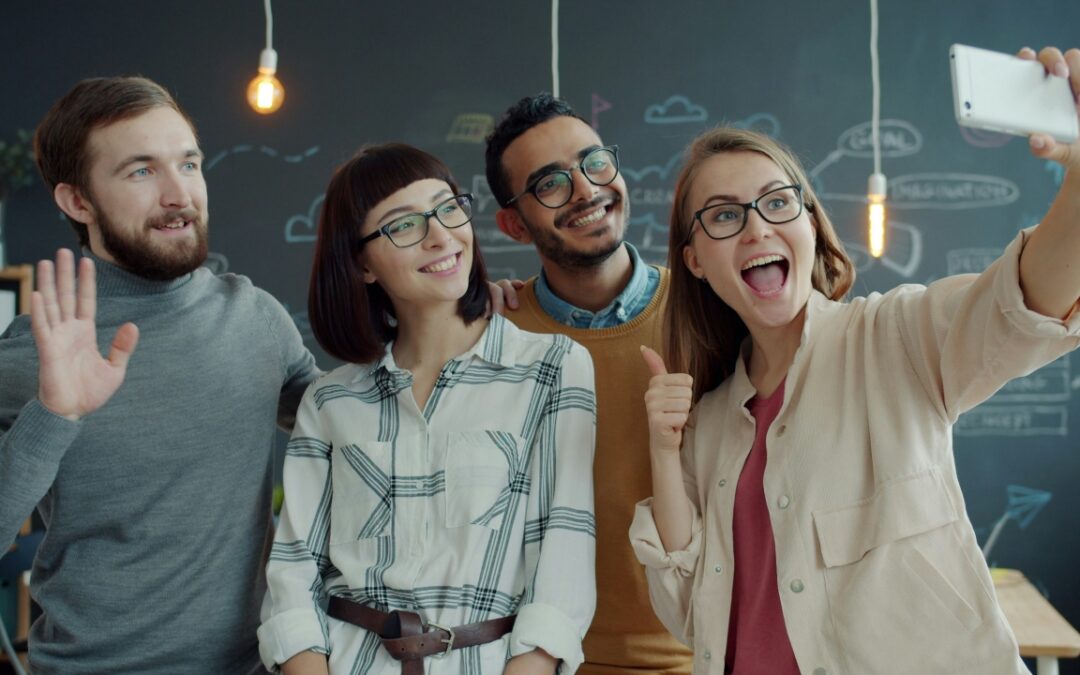
by Robyn Bolton | Oct 28, 2025 | Leadership, Strategy
Last week, I shared that 74% of executives believe that their organizations will cease to exist in ten years. They believe that strategic transformation is required, but cite the obvious problem of organizational inertia and the easy scapegoat of people’s resistance to change.
Great. Now we know the problem. What’s the solution?
The Obvious: Put the Right People in Leadership Roles
Flipping through the report, the obvious answers (especially from an executive search firm) were front and center:
- Build a top team with relevant experience, competencies, and diverse backgrounds
- Develop the team and don’t be afraid to make changes along the way
- Set a common purpose and clear objectives, then actively manage the team
The Easy: Do Your Job as a Leader
OK, these may not be easy but it’s not that hard, either:
- Relentlessly and clearly communicate the why behind the change
- Change one thing at a time
- Align incentives to desired outcomes and behaviors
- Be a role model
- Understand and manage culture (remember, it’s reflected in the worst behaviors you tolerate)
The Not-Obvious-or-Easy-But-Still-Make-or-Break: Deputize the Next Generation
Buried amongst the obvious and easy was a rarely discussed, let alone implemented, choice – actively engaging the next generation of leaders.
But this isn’t the usual “invite a bunch of Hi-Pos (high potentials) to preview and upcoming announcement or participate in a focus group to share their opinions” performance most companies engage in.
This is something much different.
Step 1: Align on WHY an “extended leadership team” of Next Gen talent is mission critical
The C-Suite doesn’t see what happens on the front lines. It doesn’t know or understand the details of what’s working and what’s not. Instead, it receives information filtered through dozens of layers, all worried about positioning things just right.
Building a Next Gen extended leadership team puts the day-to-day realities front and center. It brings together capabilities that the C-Suite team may lack and creates the space for people to point out what looks good on paper but will be disastrous in practice.
Instead, leaders must commit to the purpose and value of engaging the next generation, not merely as “sensing mechanisms” (though that’s important, too) but as colleagues with different and equally valuable experiences and insights.
Step 2: Pick WHO is on the team without using the org chart
High-potentials are high potential because they know how to succeed in the current state. But transformation isn’t about replicating the current state. It requires creating a new state. For that, you need new perspectives:
- Super connecters who have wide, diverse, and trusted relationships across the organization so they can tap into a range of perspectives and connect the dots that most can barely see
- Credible experts who are trusted for their knowledge and experience and are known to be genuinely supportive of the changes being made
- Influencers who can rally the troops at the beginning and keep them motivated throughout
Step 3: Give them a clear mandate (WHAT) but don’t dictate HOW to fulfill it
During times of great change, it’s normal to want to control everything possible, including a team of brilliant, creative, and committed leaders. Don’t involve them in the following steps and be open to being surprised by their approaches and insights:
- At the beginning, involve them in understanding and defining the problem and opportunity.
- Throughout, engage them as advisors and influencers in decision-making (
- During and after implementation, empower them to continue to educate and motivate others and to make adaptations in real-time when needed.
Co-creation is the key to survival
Transforming your organization to survive, even thrive, in the future is hard work. Why not increase your odds of success by inviting the people who will inherit what you create to be part of the transformation?

by Robyn Bolton | Sep 30, 2025 | Leading Through Uncertainty, Strategy, Tips, Tricks, & Tools
Just as we got used to VUCA (volatile, uncertain, complex, ambiguous) futurists now claim “the world is BANI now.” BANI (brittle, anxious, nonlinear, incomprehensible) is much worse than VUCA and reflects “the fractured, unpredictable state of the modern world.”
Not to get too Gen X on the futurists who coined and are spreading this term but…shut up.
Is the world fractured and unpredictable? Yes.
Does it feel brittle? Are we more anxious than ever? Are things changing at exponential speed, requiring nonlinear responses? Does the world feel incomprehensible? Yes, to all.
Naming a problem is the first step in solving it. The second step is falling in love with the problem so that we become laser focused on solving it. BANI does the first but fails at the second. It wallows in the problem without proposing a path forward. And as the sign says, “Ain’t nobody got time for this.”
(Re)Introducing the Cynefin Framework
The Cynefin framework recognizes that leadership and problem-solving must be contextual to be effective. Using the Welsh word for “habitat,” the framework is a tool to understand and name the context of a situation and identify the approaches best suited for managing or solving the situation.
It’s grounded in the idea that every context – situation, challenge, problem, opportunity – exists somewhere on a spectrum between Ordered and Unordered. At the Ordered end of the spectrum, cause and affect are obvious and immediate and the path forward is based on objective, immutable facts. Unordered contexts, however, have no obvious or immediate relationship between cause and effect and moving forward requires people to recognize patterns as they emerge.
Both VUCA and BANI point out the obvious – we’re spending more time on the Unordered end of the spectrum than ever. Unlike the acronyms, Cynefin helps leaders decide and act.
5 Contexts. 5 Ways Forward
The Cynefin framework identifies five contexts, each with its own best practices for making decisions and progress.
On the Ordered end of the spectrum:
- Simple contexts are characterized by stability and obvious and undisputed right answers. Here, patterns repeat, and events are consistent. This is where leaders rely on best practices to inform decisions and delegation, and direct communication to move their teams forward.
- Complicated contexts have many possible right answers and the relationship between cause and effect isn’t known but can be discovered. Here, leaders need to rely on diverse expertise and be particularly attuned to conflicting advice and novel ideas to avoid making decisions based on outdated experience.
On the Unordered end of the spectrum:
- Complex contexts are filled with unknown unknowns, many competing ideas, and unpredictable cause and effects. The most effective leadership approach in this context is one that is deeply uncomfortable for most leaders but familiar to innovators – letting patterns emerge. Using small-scale experiments and high levels of collaboration, diversity, and dissent, leaders can accelerate pattern-recognition and place smart bets.
- Chaos are contexts fraught with tension. There are no right answers or clear cause and effect. There are too many decisions to make and not enough time. Here, leaders often freeze or make big bold decisions. Neither is wise. Instead, leaders need to think like emergency responders and rapidly response to re-establish order where possible to bring the situation into a Complex state, rather than trying to solve everything at once.
The final context is Disorder. Here leaders argue, multiple perspectives fight for dominance, and the organization is divided into fractions. Resolution requires breaking the context down into smaller parts that fit one of the four previous contexts and addressing them accordingly.
The Only Way Out is Through
Our VUCA/BANI world isn’t going to get any simpler or easier. And fighting it, freezing, or fleeing isn’t going to solve anything. Organizations need leaders with the courage to move forward and the wisdom and flexibility to do so in a way that is contextually appropriate. Cynefin is their map.

by Robyn Bolton | Sep 2, 2025 | Leading Through Uncertainty, Strategy
In September 2011, the English language officially died. That was the month that the Oxford English Dictionary, long regarded as the accepted authority on the English language published an update in which “literally” also meant figuratively. By 2016, every other major dictionary had followed suit.
The justification was simple: “literally” has been used to mean “figuratively” since 1769. Citing examples from Louisa May Alcott’s Little Women, Charles Dickens’ David Copperfield, Charlotte Bronte’s Jane Eyre, and F. Scott Fitzgerald’s The Great Gatsby, they claimed they were simply reflecting the evolution of a living language.
What utter twaddle.
Without a common understanding of a word’s meaning, we create our own definitions which lead to secret expectations, and eventually chaos.
And not just interpersonally. It can affect entire economies.
Maybe the state of the US economy is just a misunderstanding
Uncertainty.
We’re hearing and saying that word a lot lately. Whether it’s in reference to tariffs, interest rates, immigration, or customer spending, it’s hard to go a single day without “uncertainty” popping up somewhere in your life.
But are we really talking about “uncertainty?”
Uncertainty and Risk are not the same.
The notion of risk and uncertainty was first formally introduced into economics in 1921 when Frank Knight, one of the founders of the Chicago school of economics, published his dissertation Risk, Uncertainty and Profit. In the 114 since, economists and academics continued to enhance, refine, and debate his definitions and their implications.
Out here in the real world, most businesspeople use them as synonyms meaning “bad things to be avoided at all costs.”
But they’re not synonyms. They have distinct meanings, different paths to resolution, and dramatically different outcomes.
Risk can be measured and/or calculated.
Uncertainty cannot be measured or calculated
The impact of tariffs, interest rates, changes in visa availability, and customer spending can all be modeled and quantified.
So it’s NOT uncertainty that’s “paralyzing” employers. It’s risk!
Not so fast my friend.
Not all Uncertainties are the same
According to Knight, Uncertainty drives profit because it connects “with the exercise of judgment or the formation of those opinions as to the future course of events, which…actually guide most of our conduct.”
So while we can model, calculate, and measure tariffs, interest rates, and other market dynamics, the probability of each outcome is unknown. Thus, our response requires judgment.
Sometimes.
Because not all uncertainties are the same.
The Unknown (also known as “uncertainty based on ignorance”) exists when there is a “lack of information which would be necessary to make decisions with certain outcomes.”
The Unknowable (“uncertainty based on ambiguity”) exists when “an ongoing stream [of information] supports several different meanings at the same time.”
Put simply, if getting more data makes the answer obvious, we’re facing the Unknown and waiting, learning, or modeling different outcomes can move us closer to resolution. If more data isn’t helpful because it will continue to point to different, equally plausible, solutions, you’re facing the Unknowable.
So what (and why did you drag us through your literally/figuratively rant)?
If you want to get unstuck – whether it’s a project, a proposal, a team, or an entire business, you first need to be clear about what you’re facing.
If it’s a Risk, model it, measure it, make a decision, move forward.
If it’s an uncertainty, what kind is it?
If it’s Unknown, decide when to decide, ask questions, gather data, then, when the time comes, decide and move forward
If it’s Unknowable, decide how to decide then put your big kid pants on, have the honest and tough conversations, negotiate, make a decision, and move on.
I mean that literally.

by Robyn Bolton | Aug 4, 2025 | Leadership, Leading Through Uncertainty, Stories & Examples, Strategy
The best business advice can destroy your business. Especially when you follow it perfectly.
Just ask Johnny Cash.
After bursting onto the scene in the mid-1950s with “Folsom Prison Blues”, Cash enjoyed twenty years of tremendous success. By the 1970s, his authentic, minimalist approach had fallen out of favor.
Eager to sell records, he pivoted to songs backed by lush string arrangements, then to “country pop” to attract mainstream audiences and feed the relentless appetite of 900 radio stations programming country pop full-time.
By late 1992, Johnny Cash’s career was roadkill. Country radio had stopped playing his records, and Columbia Records, his home for 25 years, had shown him the door. At 60, he was marooned in faded casinos, playing to crowds preferring slot machines to songs.
Then he took the stage at Madison Square Garden for Bob Dylan’s 30th anniversary concert.
In the audience sat Rick Rubin, co-founder of Def Jam Recordings and uber producer behind Public Enemy, Run-DMC, and Slayer, amongst others. He watched in awe as Cash performed, seeing not a relic but raw power diluted by smart decisions.
The Stare-Down that Saved a Career
Four months later, Rubin attended Cash’s concert at The Rhythm Café in Santa Anna, California. According to Cash’s son, “When they sat down at the table, they said: ‘Hello.’ But then my dad and Rick just sat there and stared at each other for about two minutes without saying anything, as if they were sizing each other up.”
Eventually, Cash broke the silence, “What’re you gonna do with me that nobody else has done to sell records for me?”
What happened next resurrected his career.
Rubin didn’t promise record sales. He promised something more valuable: creative control and a return to Cash’s roots.
Ten years later, Cash had a Grammy, his first gold record in thirty years, and CMA Single of the Year for his cover of Nine Inch Nails’ “Hurt,” and millions in record sales.
When Smart Decisions Become Fatal
Executives do exactly what Cash did. You respond to market signals. You pivot your offering when customer preferences shift and invest in emerging technologies.
All logical. All defensible to your board. All potentially fatal.
Because you risk losing what made you unique and valuable. Just as Cash lost his minimalist authenticity and became a casualty of his effort to stay relevant, your business risks losing sight of its purpose and unique value proposition.
Three Beliefs at the Core of a Comeback
So how do you avoid Cash’s initial mistake while replicating his comeback? The difference lies in three beliefs that determine whether you’ll have the creative courage to double down on what makes you valuable instead of diluting it.
- Creative confidence: The belief we can think and act creatively in this moment.
- Perceived value of creativity: Our perceived value of thinking and acting in new ways.
- Creative risk-taking: The willingness to take the risks necessary for active change.
Cash wanted to sell records, and he:
- Believed that he was capable of creativity and change.
- Saw the financial and reputational value of change
- Was willing to partner with a producer who refused to guarantee record sales but promised creative control and a return to his roots.
Your Answers Determine Your Outcome
Like Cash, what you, your team, and your organization believe determines how you respond to change:
- Do I/we believe we can creatively solve this specific challenge we’re facing right now?
- Is finding a genuinely new approach to this situation worth the effort versus sticking with proven methods?
- Am I/we willing to accept the risks of pursuing a creative solution to our current challenge?”
Where there are “no’s,” there is resistance, even refusal, to change. Acknowledge it. Address it. Do the hard work of turning the No into a Yes because it’s the only way change will happen.
The Comeback Question
Cash proved that authentic change—not frantic pivoting—resurrects careers and disrupts industries. His partnership with Rubin succeeded because he answered “yes” to all three creative beliefs when it mattered most. Where are your “no’s” blocking your comeback?

by Robyn Bolton | Jul 8, 2025 | Strategic Foresight, Strategy
You stand on the brink of an exciting new adventure. Turmoil and uncertainty have convinced you that future success requires more than the short-term strategic and business planning tools you’ve used. You’ve cut through the hype surrounding Strategic Foresight and studied success. You are ready to lead your company into its bold future.
So, where do you start?
Most executives get caught up in all the things that need to happen and are distracted by all the tools, jargon, and pretty pictures that get thrown at them. But you are smarter than that. You know that there are three things you must do at the beginning to ensure ultimate success.
Give Foresight Executive Authority and Access
Foresight without responsibility is intellectual daydreaming.
While the practice of research and scenario design can be delegated to planning offices, the responsibility for debating, deciding, and using Strategic Foresight must rest with P&L owners.
Amy Webb’s research at NYU shows that when a C-Suite executive with the authority to force strategic reviews oversaw foresight activities, the results were more likely to be acted on and integrated into strategic and operational plans. Shell serves as a specific example of this, as its foresight team reported directly to the executive committee, so that when scenarios explored dramatic oil price volatility, Shell executives personally reviewed strategic portfolios and authorized immediate capability building.
Start by asking:
- Who can force strategic reviews outside of the traditional planning process?
- What triggers a review of Strategic Foresight scenarios?
- How do we hold people accountable for acting on insights?
Demand Inputs That Challenge Your Assumptions
If your Strategic Foresight conversations don’t make you uncomfortable, you’re doing them wrong.
Webb’s research also shows that successful foresight systematically explores fundamental changes that could render the existing business obsolete.
Shell’s scenarios went beyond assumptions about oil price stability to explore supply disruptions, geopolitical shifts, and demand transformation. Disney’s foresight set aside traditional assumptions about media consumption and explored how technology could completely reshape content creation, distribution, and consumption.
Start by asking these questions:
- Is the team going beyond trend analysis and exploring technology, regulations, social changes, and economic developments that could restructure entire markets?
- Who are we talking to in other industries? What unusual, unexpected, and maybe crazy sources are we using to inform our scenarios?
- Does at least one scenario feel possible and terrifying?
Integrate Foresight into Existing Planning Processes
Strategic Foresight that doesn’t connect to resource allocation decisions is expensive research.
Your planning processes must connect Strategic Foresight’s long-term scenarios to Strategic Planning’s 3–5-year plans and to your annual budget and resource decisions. No separate foresight exercises. No parallel planning tracks. The cascade from 20-year scenarios to this year’s investments must be explicit and ruthless.
When Shell’s scenarios explored dramatic oil price volatility over decades, Shell didn’t file them away and wait for them to come true. They immediately reviewed their strategic portfolio and developed a 3–5-year plan to build capabilities for multiple oil futures. This was then translated into immediate capital allocation changes.
Disney’s foresight about changing media consumption in the next 20 years informed strategic planning for Disney+ and, ultimately, its operational launch.
Start by asking these questions:
- How is Strategic Foresight linked to our strategic and business planning processes?
- How do scenarios flow from 20-year insights through 5-year strategy to this year’s budget decisions?
- How is the integration of Strategic Foresight into annual business planning measured and rewarded?
Three Steps. One Outcome.
Strategic foresight efforts succeed when they have the executive authority, provocative inputs, and integrated processes to drive resource allocation decisions. Taking these three steps at the very start sets you, your team, and your organization up for success. But they’re still not a guarantee.
Ready to avoid the predictable pitfalls? Next week, we’ll consider why strategic foresight fails and how to prevent your efforts from joining them.

by Robyn Bolton | Jun 25, 2025 | Leadership, Stories & Examples, Strategy
Convinced that Strategic Foresight shows you a path through uncertainty? Great! Just don’t rush off, hire futurists, run some workshops, and start churning out glossy reports.
Activity is not achievement.
Learning from those who have achieved, however, is an excellent first activity. Following are the stories of two very different companies from different industries and eras that pursued Strategic Foresight differently yet succeeded because they tied foresight to the P&L.
Shell: From Laggard to Leader, One Decision at a Time
It’s hard to imagine Shell wasn’t always dominant, but back in the 1960s, it struggled to compete. Tired of being blindsided by competitors and external events, they sought an edge.
It took multiple attempts and more than 10 years to find it.
In 1959, Shell set up their Group Planning department, but its reliance on simple extrapolations of past trends to predict the future only perpetuated the status quo.
In 1965, Shell introduced the Unified Planning Machinery, a computerized forecasting tool to predict cash flow based on current results and forecasted changes in oil consumption. But this approach was abandoned because executives feared “that it would suppress discussion rather than encourage debate on differing perspectives.”
Then, in 1967, in a small 18th-floor office in London, a new approach to ongoing planning began. Unlike past attempts, the goal was not to predict the future. It was to “modify the mental model of decision-makers faced with an uncertain future.”
Within a few years, their success was obvious. Shell executives stopped treating scenarios as interesting intellectual exercises and started using them to stress-test actual capital allocation decisions.
This doesn’t mean they wholeheartedly embraced or even believed the scenarios. In fact, when scenarios suggested that oil prices could spike dramatically, most executives thought it was far-fetched. Yet Shell leadership used those scenarios to restructure their entire portfolio around different types of oil and to develop new capabilities.
The result? When the 1973 oil crisis hit and oil prices quadrupled from $2.90 to $11.65 per barrel, Shell was the only major oil company ready. While competitors scrambled and lost billions, Shell turned the crisis into “big profits.”
Disney: From Missed Growth Goals to Unprecedented Growth
In 2012, Walt Disney International’s (WDI) aggressive growth targets collided with a challenging global labor market, and traditional HR approaches weren’t cutting it.
Andy Bird, Chairman of Walt Disney International, emphasized the criticality of the situation when he said, “The actions we make today are going to make an impact 10 to 20 years down the road.”
So, faced with an unprecedented challenge, the team pursued an unprecedented solution: they built a Strategic Foresight capability.
WDI trained over 500 leaders across 45 countries, representing five percent of its workforce, in Strategic Foresight. More importantly, Disney integrated strategic foresight directly into their strategic planning and performance management processes, ensuring insights drove business decisions rather than gathering dust in reports.
For example, foresight teams identified that traditional media consumption was fracturing (remember, this was 2012) and that consumers wanted more control over when and how they consumed content. This insight directly shaped Disney+’s development.
The results speak volumes. While traditional media companies struggled with streaming disruption, Disney+ reached 100 million subscribers in just 16 months.
Two Paths. One Result.
Shell and Disney integrated Strategic Foresight differently – the former as a tool to make high-stakes individual decisions, the latter as an organizational capability to affect daily decisions and culture.
What they have in common is that they made tomorrow’s possibilities accountable to today’s decisions. They did this not by treating strategic foresight as prediction, but as preparation for competitive advantage.
Ready to turn these insights into action? Next week, we’ll dive into the tools in the Strategic Foresight toolbox and how you and your team can use them to develop strategic foresight that drives informed decisions.





